Fringe Review: Psi World from ZDL's blog
FGU
The absolute monarchs of the '80s vibe were Fantasy Games Unlimited (FGU) There was not a crazy concept they weren't willing to champion and publish. The first "realistic" medieval game (Chivalry & Sorcery) was theirs. The first game to feature non-humanoids as the central characters (Bunnies & Burrows) was theirs. The first popular superhero RPG (Villains & Vigilantes) was theirs. The first medieval Japanese RPG (Land of the Rising Sun) was theirs as was the most popular one (Bushido) for ages. And while not the first SF games ever, two of the earliest SF games (Starships & Spacemen, Space Opera) were theirs too, the latter of which still causes warm fuzzy feelings when I think back to its convoluted insanity but immense fun.
They also covered mercenary operations (Merc), three musketeer-style gaming (Flashing Blades), post-holocause roleplaying (Aftermath!), pulp fiction (Daredevils) and a whole host of others.
One of the hallmarks of their games was always the sheer rampant complexity of them, complexity which had a constant upward trend (though some of their earliest works like Chivalry & Sorcery and Space Opera had jumped high up into that sphere already) as they published more games. This led to jokes like "Aftermath was called this because AFTER the MATH you don't have time to play!".
Psi World
And in the middle of all this is the subject of today's Fringe Review: Psi World.
Psi World was an oddity in the midst of the ramping-up complexity of FGU games. It was, by the standards of the '80s era of game design, a rather simple game. (By modern standards it might be considered moderately complicated ... not because of the number of rules but rather because of the inconsistencies in them.) It had an intriguing implied (and in later published adventures, explicit) campaign world. And it had a unique focus on purely psionics: telepaths, telekinetics, etc. It was not a general purpose science fiction game; it was set in the near future and, psionics aside, it was a recognizable world not to different from ours (as envisioned as near future in the '80s). There were no aliens, space travel was limited, there was no magic, and technology hadn't overrun the world because cyberpunk was still a niche genre that hadn't been done to death.
It's also probably my favourite game from that era.
The Basics
Psi World came in a boxed set with two books: a book of rules and a book with an adventure that contained the implied setting more explicitly. (Later published adventures expanded on said setting.) The rules occupy 32 pages (a miraculously small game for that era of FGU!) and the adventure a further 20. A collection of reference sheets and a character sheet rounds out the set. Typography is as typical for FGU's offering with a small, but readable font, very basic layout--competent but not great (it has a lot of one of my pet peeves in layout, unfortunately: column-split sidebars)--and writing that is, while uninspired, at least mostly clear. Cover and internal art is slightly amateurish, but flavourful. It's largely a mixed bag.
System
Characters all have six attributes: Strength (STR), Agility (AGL), Dexterity (DEX), Endurance (END), Intelligence (INT), and Will (WIL). Psionic characters have one additional attribute: Psionic Power (PSI). These are rolled on 2d10 each and may either be rolled one at a time sequentially, or have the appropriate number of rolls made and assigned at the player's option depending on which approach the GM prefers. Each attribute except PSI has an attribute saving throw (AST) that defaults to 4x the stat as a percentage. Difficulties in such saving throws can be expressed by changing the multiplier or by modifying the roll.
At this point we see some of the '80s-era ethos and its tendency toward inconsistency. In some circumstances positive modifiers are good and negative modifiers are bad. In other circumstances it's the other way around. This can be a bit confusing at first until you get the hang of why. I think a better designer would have made things ab it more consistent.
As is typical for old school games, the stats are used to generate bonuses and penalties for a variety of calculated combat factors. These are Initiative Factor, Defense Bonus, Bonus to Hit, Damage Bonus, and Hit Points.
Here, again, we have another example of the mild inconsistencies of the game. Attribute bonuses differ from bonus to bonus (and even within a given bonus). For example the defense bonus for Agility ranges from +5 (attribute 01-05) to -15 (attribute 19-20). Intelligence contributions range from +2 to -10. Each bonus has its own set of bonuses making it a bit irritating to keep track of. This is a minor criticism, however, given the small number of rules and that this happens only in character generation.
Hit points, however, are calculated using a hilariously silly approach. Keep in mind that I'm not making any of this up. This is the actual process. First add the average of STR and WIL to END and take the average of that. ((STR+WIL)/2+END)/2 is the formula given in the book. This gives you a "hit point number". Not your hit points, however. That is, instead, the number of d3 you roll. This gives you your "hit point base". This is then FURTHER modified by modifers for STR, WIL, and END.
Yes. You read that right. You use STR, WIL, and END to decide how many dice to roll for your hit points, then modify that result by factors determined from STR, WIL, and END... This is beyond silly, especially since it's possible with this system to wind up having negative starting hit points. If this happens, you throw away everything you've done thus far and start over from the beginning. The character is presumed to have died in childbirth. (No, really. That's what it says!)
Hit points are both global and localized: there's separate hit point totals for head, chest, abdomen, each arm, and each leg. Total hit points falling to 0 means you're out of the action and individual location hit points being exceeded have effects that vary according to the area hit. This is mostly common sense and easy to remember. Rules for healing and training of attributes are present and fairly simple (although training up an attribute is a VERY lengthy procedure; using experience is a better approach).
The system is skills-based. Psionic characters get access to fewer skills than their non-psionic counterparts which makes sense as part of the implied setting. (Note: not fewer skill points, just restricted access to types of skills. All characters get 4d10 skill points to buy skills with.) Skills are divided into two major kinds: non-level and level. Non-level skills cost one skill point and are have/have-not skills (like "Dancing"), though "Mastery" can be used to increase character abilities further in them. Leveled skills are ranked by Level of Difficulty to learn and are purchased in blocks of 10%. Skill points can optionally be tied to character age (and it's an option that we always used when we played) thus making more-skilled characters older.
Skills are divided into General Skills, Technical Skills, Military Skills, Spacer Skills, and Academic/Advanced Skills. The skills list is straightforward and the explanations both succinct and clear. Usage is basic d% resolution with a difficulty level system slathered on top: each shift in level of difficulty adds or subtracts from the skill level by 10%. Most game time modifiers are difficulty modifications (but, again, '80s game, so not always). Skills may be improved by study and by learning, as with attributes, and may also be "mastered".
All of this, however, is just a warm-up for the bulk of the book: psionics. This makes sense given that this is a game of psionic characters (protagonist or antagonist). As with attributes, there are two ways of making character psionic abilities: random or design. Designed characters may select either one Major or two Minor disciplines of the player's choice. Random characters roll once on the major disciplines or 1d2+1 times on the minor disciplines tables taking the discipline rolled with a slight chance of getting additional rolls on one or the other table. Major disciplines are large groups of powers under a common heading (like "telepathy" while minor disciplines are more limited with one or two basic functions only, several of which involve permanent, one-time adjustments to the character (like "genius"). It should be noted that the PCs are considered to be the "royalty", so to speak, of psionics: the 10% with the most impressive powers. Most psionic NPCs have limited to useless powers.
This is the part of the game that shines. It is a well-thought out setup with good, flavourful powers combined with all the usual standby abilities you'd expect. It is primarily the psionic powers section that has kept this game in my memory for so long. In only 8 pages of text, a unique and flavourful psionic powers system is presented that makes up for the minor flaws (and the laugh-worthy hit point roll!) elsewhere in the game.
And then it provides a simple framework for creating new abilities in-character.
The combat chapter is written rather like it is in shorthand for people who already understand how combat in role-playing games work. It's made with decent craftsmanship, but it is tersely written and I suspect players new to RPGs (or at least to the old-school variety) might find it a bit hard to puzzle out. Combat rounds are ten seconds long, turns are one minute, and one "strategic unit" is one hour. The game operates in typical wargame-influenced style with initiative roll, movement rules, and then combat resolution. The game system is, thankfully, pretty regular, and it has an unarmed combat system that is both relatively detailed and in line with every other kind of attack. The inevitable-for-the-'80s grenade scattering roll exists, too (introducing the SINGLE TIME in all the rules where a d8 is needed...). The inevitable almost fetish-level listing of weapons and their stats then closes out the chapter.
The World
The final chapter talks about "the world" but is really more just some mild advice on how to select and run a setting for the game. The real setting information is provided in the paired adventure book.
The adventure book introduces the author's playtest world where the hints of the implied setting are made explicit. It has a world divided up into the racial and social concerns of the time and in its history details the chaos and carnage caused as psionics erupted around the world. The resulting troubles caused a rift between normal humans and psionics that continues to this day where the "Psionic Protection Agency" (PPA) defends the populace from psionic crime. The major choice in the campaign is whether or not the PPA is the good guys (i.e. the PCs work for the PPA) acting as the thin blue line between Psis and humans, or if they're a repressive force trying to stamp out the psionic mutation once and for all.
(In every game I ever played we enjoyed the latter idea more.)
Bringing the dry setting facts to life are two adventures: one for psionic characters fighting the PPA and one for the PPA fighting the psis. Both are nicely detailed, complete with maps, NPCs, an overall plot, and enough sandbox material to support a non-railroaded session.
Observations
I'm not going to hide it (and didn't above): I love this game. The psionic system at the core of it is so memorable that, despite having not played this game for 20 years, I still have many fond memories of it. The game system, albeit with a few minor warts, is amazingly simple given its time of creation, and it shows enough imagination and thought that it largely stays out of the way. A lot of newer games could learn from this one.
It is, however, quite unabashedly a purely old-school game. It is clearly in the gaming side of things, and specifically very obviously still influenced by the miniatures wargaming that created our hobby. This is NOT a "modern" narrative-oriented game. It is primarily simulation in focus. Combat can be unforgiving, and knowledge of the game system is needed to be effective in playing it. (Thankfully it is a small and simple game system and thus easy to learn and apply.)
Its presentation is basic, but craftsmanlike, and the extras, especially the combat reference sheets, take things a long way toward making it quick and easy to run. Is it worth picking up? Well, at the price it's selling for I'm going to weigh in with "yes". The price it is currently set at is well within a whimsy purchase and even if the game itself winds up not appealing, the psionic system alone can have ideas lifted for other games.







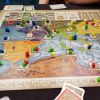
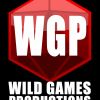
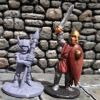
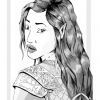


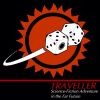


The Wall